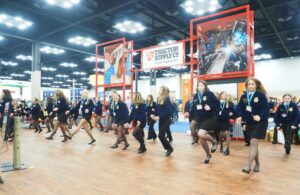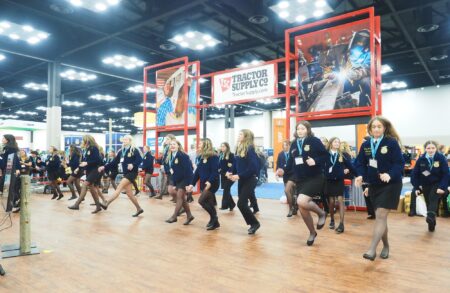Proper dairy barn ventilation throughout the year helps ensure cow comfort, which can have a direct impact on production. But good ventilation in a barn, summer or winter, is much more than simply turning on a fan or opening a curtain. Good ventilation means airflow reaches the cows at their level.
In its most basic definition, ventilation is important to remove stale, noxious air and bring in fresh air. “Ventilation is just generally important for the health of the animal,” said Jennifer Van Os, assistant professor and Extension specialist for animal welfare at the University of Wisconsin-Madison. “We are well aware of the need for proper ventilation for young calves, but it’s also true for adult cows. We need to be sure that we are cycling in fresh air from the outside at a minimum rate per hour. That’s especially true in the summer, but it’s equally important throughout the year.”
Evaluating Your Facilities
It’s a bit simplistic to characterize ventilation as simply moving air in and out of the barn. Proper airflow throughout a facility at a rate that benefits the cows is critical. That’s because in any barn, airflow can be restricted or obstructed.
“When we evaluate facilities on proper airflow, we work with producers to help them recognize whether ventilation is having an impact on their herd,” said Kirk Brincks, former vice president of sales and marketing for J&D Manufacturing. A minimum amount of ventilation is necessary in cold weather, just as summer has its requirements. It’s all in an effort to keep cows comfortable because comfortable cows are productive cows.
Overall, the industry is moving toward understanding the impact of the temperature and humidity index (THI). “In the past, the approach was to turn the fans on when it’s hot, or reduce the fan speed when the weather turns cold,” Brincks said. “But understanding THI may mean full ventilation when the temperature is lower but humidity is higher. THI indicates that you may start hurting milk production and crossing heat stress levels at lower temperatures than you might expect.”
For example, an outside temperature of 75°F and 20% relative humidity may require full ventilation, but a lower temperature of 70°F with a higher relative humidity may equally need full ventilation. “If you stay ahead of the heat stress with ventilation, you may avoid a hit to milk production,” Brincks said. “THI is a more accurate indicator than using temperature alone.”
Cold weather also means proper ventilation. “Producers often try and keep the heat in during cold spells by reducing ventilation,” Brincks said. “But bad air quality in cold weather elevates the risk of pneumonia. You can also see elevated humidity levels. It’s important to realize that cows are quite comfortable at lower temperatures and benefit greatly from a good airflow.”
Courtesy of J&D Manufacturing
Measure at the Cow Level
To know just how well the air flows through your barn, measurement is key. That doesn’t mean testing in just the alleyways. It means getting down to the cow level … literally. “It’s not just the number of fans, or the size of the fans, or how many cfms your fans deliver,” Van Os said. “You want to measure at the cow’s resting height in stalls in every area of the pen and see if there are any gaps.”
Just as the current in a river, flow in some areas can be reduced for a variety of reasons. The solution can be as simple as adjusting the fan’s direction, or as complex as dealing with something outside the barn that is restricting airflow. For instance, an adjoining cornfield might see reduced airflow when the crop is mature versus when the field is barren.
“There are a lot of different elements to installing and calibrating your fan systems,” Van Os said. “There’s no one-size-fits-all approach. That’s why it’s really important to measure what the fans are actually delivering once they are in place. The goal is at least 200 feet per minute in all stalls.”
Van Os said a common issue often arises when fans are placed only in the feed bunk. “Several studies have shown that during the summer, when cows lie down they start to accumulate body heat, so their body temperature and respiratory rate start to rise,” she said. “They then stand up, start to dissipate heat, and their body temperature and respiratory rate start to go down. So at the feed bunk, even though cows are feeding, and they are generating metabolic heat from eating and ruminating, they can better cope with heat when they are standing up. So we want to make sure that if there’s a choice between fans in the feed bunk and the stalls, we want to see them over the stalls.”
Brincks said thoroughly evaluating barn ventilation is critical to ensuring you are putting your resources into improving it most efficiently. “It could be a simple matter of adjusting your fans, ensuring your inlets and outlets are not blocked, or basic maintenance of your existing fans,” he said.
Dirty fans are inefficient, failing to push as much air as clean fans. Older fans can also be subject to normal component wear, including belts and pulleys, that need periodic servicing and adjusting. Damaged inlets and outlets may not operate properly, so they need to be adjusted.
“We recommend a spring and fall evaluation of your ventilation system, so you are prepared for the summer heat and winter cold,” Brincks said. “Ensuring proper ventilation won’t fix every herd health problem, but it is a leading cause of many issues we see. And it’s something we can have control over.”


:max_bytes(150000):strip_icc()/soybeans_usb-2-2000-f3cbf2d5ad334bbca68c6fb09087a9cd.jpg)
:max_bytes(150000):strip_icc()/36308607503_af1bc9a487_o-1deb3ddd8dd24d7c83b4f3760435f3fd.jpg)



:max_bytes(150000):strip_icc()/FansabovecowsCourtesyofJDManufacturing-da5b90523fc146eb95ac77ad0eadcc34.jpeg)

:max_bytes(150000):strip_icc()/Iowa-State-Fair-Banner-d22e8c0989b142aabefb048e52d85521.jpg)

